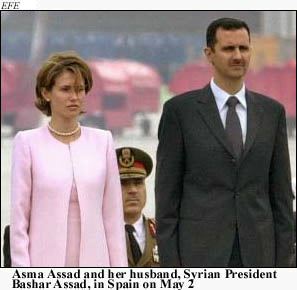 |
| Vol. 3 No. 6 | Table of Contents MEIB Main Page | June 2001 |
| | Dossier: Asma Assad First Lady of Syria |
 |
After spending nearly three months in virtual seclusion from the public since her marriage to the Syrian president late last year, 25-year old Asma Assad suddenly materialized on Syrian television in March, appearing unveiled and wearing an above the knee skirt as her husband chatted with the president of Bulgaria. Since then she has owned the spotlight, appearing by his side when the Pope visited Damascus, touring ancient ruins with the King of Spain during Assad's visit to Madrid, and, like the late Eva Perón, visiting with destitute children while accompanying her husband to Tunisia.
Asma al-Akhras and her two younger brothers were born in London. Her father, the scion of distinguished Sunni Muslim family in Homs, Syria is a prominent heart specialist, while her mother works for the Syrian embassy. She grew up in Acton, west London and attended a local Church of England school before completing her secondary education at Queen's College, where she was known as Emma to her classmates.
Afterwards, Asma attended King's College in London. A former professor later described her as "very bright and very outgoing," adding that she "seemed very Westernized and not in the least bit traditional."1 After graduating in 1996 with a degree in Computer Science, she worked as an economist for Deutsche Bank and JP Morgan. During her three years at JP Morgan, she was frequently dispatched to the United States and the Middle East.
How she came to know Bashar Assad has been the subject of much speculation. While most Western news reports have assumed that the two met during Assad's nine-month residency at St. Mary's Hospital in London, a reliable Syrian source insists that Asma was introduced to him after his inauguration (apparently during a visit to Syria). In any case, they were married in a private ceremony in Damascus sometime in December 2000, though the marriage was not made public until January 2, when the state-run Tishrin newspaper issued a brief announcement.
Asma initially remained out of the spotlight. She rarely appeared in public with her husband and was not photographed by the media. All of this changed on March 19, when Syrian television broadcast the first lady's photo for the first time during its coverage of Bulgarian President Petar Stoyanov's arrival in Damascus. Wearing a black and white suit, Asma stood by her husband when they greeted Stoyanov at the airport. The broadcast also showed her chatting with the Bulgarian first lady as the two leaders conversed in the VIP lounge of the Syrian airport.
In April, she was in the spotlight again, welcoming the president of Slovakia to the Syrian capital. Later that month, she accompanied her husband to Tunisia and Morocco. When Assad departed for Spain in early May, his first trip to Europe since assuming office, she remained by his side publicly throughout the three day trip, appearing glamorous and chic in a white silk suit with a matching string of pearls and Chanel purse. Just days later, she joined Assad in publicly welcoming Pope John Paul II to Damascus.
Her increasingly frequent public appearances at home are clearly intended to project an image of modernity. Not only has she appeared unveiled and in fashionable attire, but has reportedly expressed herself openly in meetings with foreign dignitaries. In April, she accompanied her husband to a technology and communications fair in Damascus, where she reportedly attended several seminars. She is even rumored to have her own office in the presidential palace - another first for the wife of a Syrian president. In addition, she travels freely to London on private visits and retains dual British-Syrian citizenship.
Now that the one-year mourning period following the death of Hafez Assad has passed, many expect Asma to assume an even greater public role, devoting herself (much like American first ladies have traditionally done) to social and humanitarian causes.
Assad's marriage to Asma has, without question, proven to be politically expedient. Having inherited a regime that is dominated by the minority Alawite community, marrying a member of the Sunni majority has conveyed a much-needed image of sectarian impartiality. Her educated, Western background projects an aura of modernity and sophistication for an authoritarian regime that is severely lacking in both. Assad, who lobbied for the appointment of a woman as Minister of Social Affairs in March 2000, emphasized the important role of women in society during his inaugural address and appointed women to posts in the judicial system for the first time, has skillfully employed symbolic gestures to gloss over the absence of systemic political reforms.
Whether Asma will prove to be another Evita, whose charisma and beauty virtually immunized Argentinean dictator Juan Perón from serious political challenges until her death in 1952, remains to be seen. But she is off to a good start.
Notes
1 The Guardian, 4 January 2001.